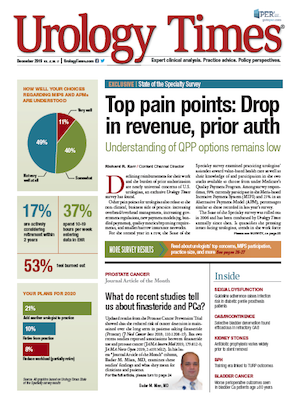Publication
Article
Urology Times Journal
What do recent studies tell us about finasteride and PCa?
Author(s):
"The relevant professional associations in the field of medicine and/or urology must do their part to inform and educate their members about the appropriate use of finasteride and PSA to eliminate avoidable morbidity and mortality from prostate cancer," writes Badar M. Mian, MD.
Kateryna_Kon - stock.adobe.com


“Journal Article of the Month” is a new Urology Times section in which Badar M. Mian, MD (left), offers perspective on noteworthy research in the peer-reviewed literature. Dr. Mian is professor of surgery in the division of urology at Albany Medical College, Albany, NY.
Finasteride (Proscar) and other 5-alpha-reductase inhibitors (5-ARIs) are most commonly used for the treatment of obstructive urinary symptoms due to enlarged prostate. Despite Level I evidence, the use of finasteride for prostate cancer prevention has not been widely adopted by the medical community.
Within the last year, updated results from the Prostate Cancer Prevention Trial (PCPT) showed that the reduced risk of cancer detection is maintained over the long term (J Natl Cancer Inst 2018; 110:1208-15; also see, “5-ARI use reduces prostate Ca risk for up to 16 years”). But a different study reported that the use of finasteride in clinical practice at VA medical centers was associated with delayed prostate cancer diagnosis, advanced stage at diagnosis, and worse cancer-specific mortality (JAMA Intern Med 2019; 179:812-9; also see, “PSA adjustments are required in men taking 5-ARIs”).
These seemingly divergent results had caused some confusion among prescribing physicians and debate among researchers. Now, another cohort study reports an association between finasteride use and delayed diagnosis of prostate cancer and worse cancer-related outcomes.
Kumar et al used the SEER-Medicare linked database to identify men with prostate cancer and known PSA at the time of diagnosis between 2008 and 2013 who also had Medicare Part D coverage (JAMA Netw Open 2019; 2:e1913612). Based on standard recommendations, the authors multiplied the PSA level by 2 to adjust for the effect of 5-ARIs. Of the 30,313 patients, 2,373 (7.83%) were prescribed 5-ARIs at least 6 months before prostate cancer diagnosis. Median duration of 5-ARI use was 2.5 years, median follow-up was 3.75 years, and median age was 72 years.
Also by Dr. Mian: Survival rates appear comparable for robotic, open cystectomy
Median adjusted PSA level at diagnosis was significantly higher in 5-ARI users (14.2 ng/mL vs. 6.6 ng/mL, p>.001). Men using 5-ARIs had more Gleason score 8-10 prostate cancers (29% vs. 18%), more high-risk cancer (38% vs. 28%), and higher rate of lymph node or distant metastases. The use of 5-ARIs was associated with increased risk of prostate cancer-specific mortality (HR, 1.38, p=.005) and all-cause mortality (HR, 1.15, p=.04).
A previous study by these authors reported similar findings in a larger, younger cohort of over 8,500 men with prostate cancer at VA medical centers who were prescribed finasteride before diagnosis. Men using 5-ARI had significantly higher adjusted PSA, high-risk cancers, and advanced stage. Prostate cancer-specific mortality for 5-ARI users was significantly higher than those using an alpha-blocker or neither (13% vs. 8%, p<.001). These adverse cancer-related outcomes were also noted in the subgroup of men age <60 years (JAMA Intern Med 2019; 179:812-9).
Contrary to the above, studies examining the long-term outcomes of men treated with finasteride have reported ongoing benefits and safety of finasteride. Unger et al analyzed the risk of prostate cancer diagnosis in over 14,000 PCPT participants with an average time between randomization to the end of the study of about 16 years. Analyzing the risk of prostate cancer diagnosis, they reported that the reduction in prostate cancer diagnosis continued even after the finasteride use had ended at 7 years. There was a 21.1% decrease in hazard ratio during the follow-up period between 7.5 to 16 years. Further, there was no evidence that stopping finasteride at the end of the trial resulted in more or worse cancer diagnoses (J Natl Cancer Inst 2018; 110:1208-15).
Next: Differences in study populationsDifferences in study populations
These studies bring to the fore several clinically relevant questions. Is the long-term use of finasteride safe and beneficial (as per PCPT follow-up) or does it result in worse cancer-related outcomes (as per current and previous study)? An understanding of the differences in the study populations would suggest that the outcomes reported by these studies are not mutually exclusive.
The PCPT included men with normal PSA using finasteride to prevent prostate cancer detection, whereas in clinical practice, 5-ARIs are used to treat voiding symptoms in men with an enlarged prostate and often an elevated PSA. The PCPT trial design had built-in mechanisms for adjusting the lab-reported PSA level (multiplied by at least 2). Apparently, this adjustment in PSA level has not been taking place in routine clinical practice as evident from the two cohort studies showing significantly high PSA levels at time of biopsy in men using 5-ARIs. Further, in the PCPT, compliance with the indications and timing of prostate biopsy was enforced through trial design, while in clinical practice, these would be at the discretion of the individual practitioners.
Read: Large study offers more evidence of ADT-Alzheimer’s link
With regard to prostate cancer and finasteride, the long-term safety (and benefits) of finasteride, when used in controlled setting (such as PCPT), have been fairly well established. Yet, now two cohort studies reported an association between 5-ARI use and a delay in prostate biopsy, resulting in worse pathologic outcomes and worse prostate cancer-specific mortality in men using 5-ARIs.
These findings should be a cause for concern. The message to prescribers should be very clear and simple. Proper adjustment of PSA level (by a factor of at least 2) is required and any increase in the PSA level of men on finasteride should prompt close follow-up and discussion about prostate biopsy. The relevant professional associations in the field of medicine and/or urology must do their part to inform and educate their members about the appropriate use of finasteride and PSA to eliminate avoidable morbidity and mortality from prostate cancer.





























